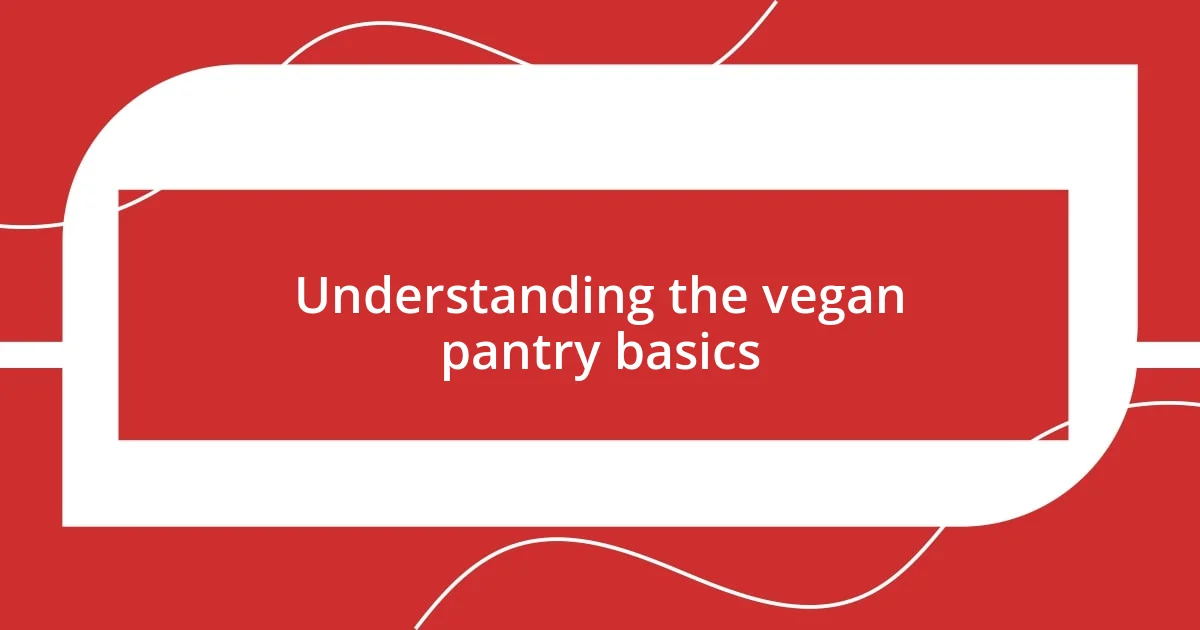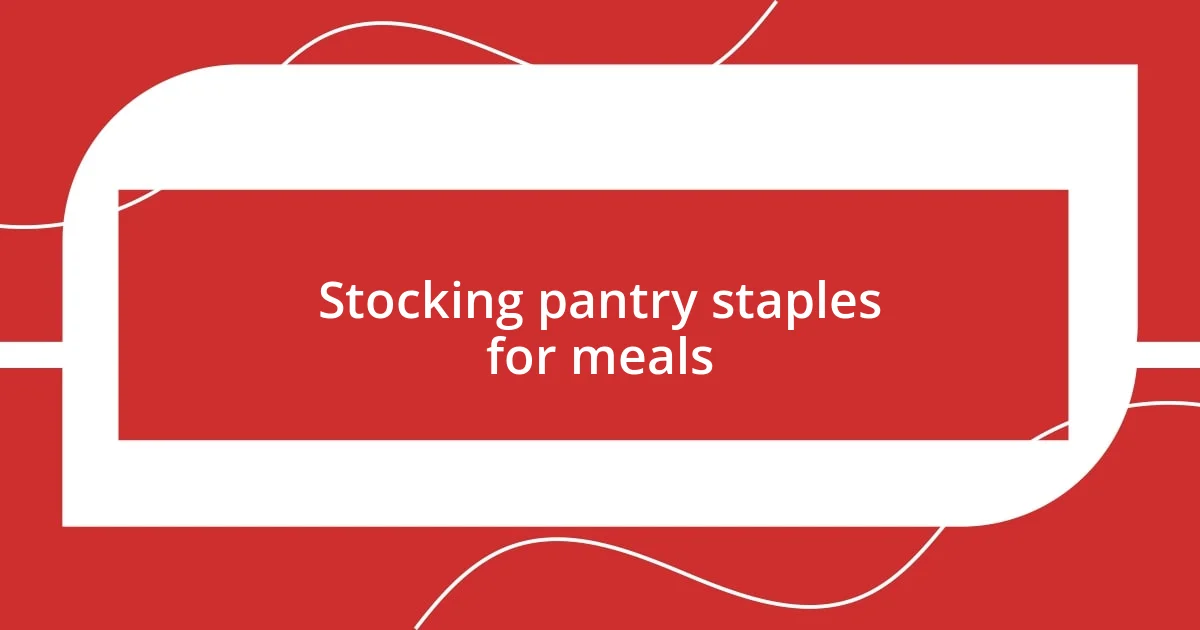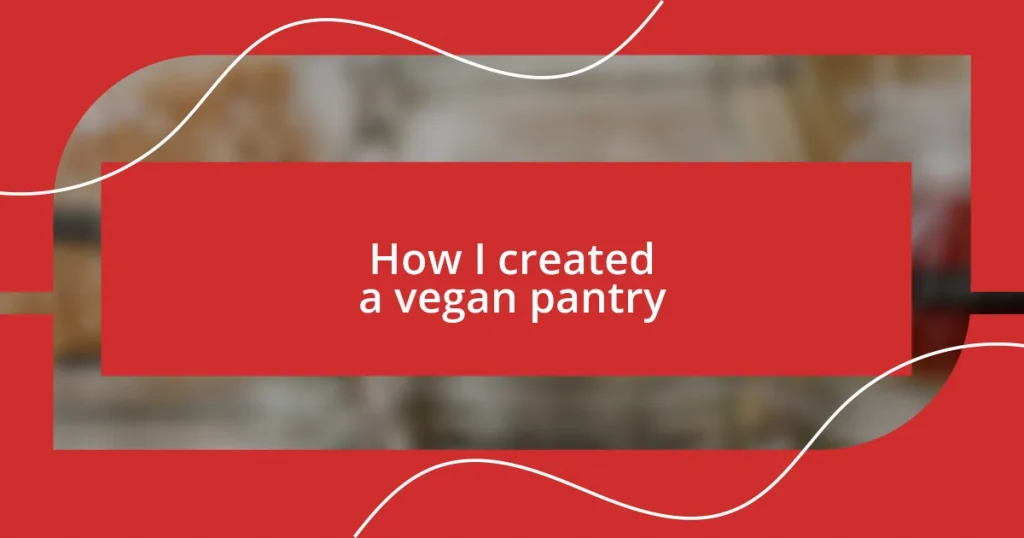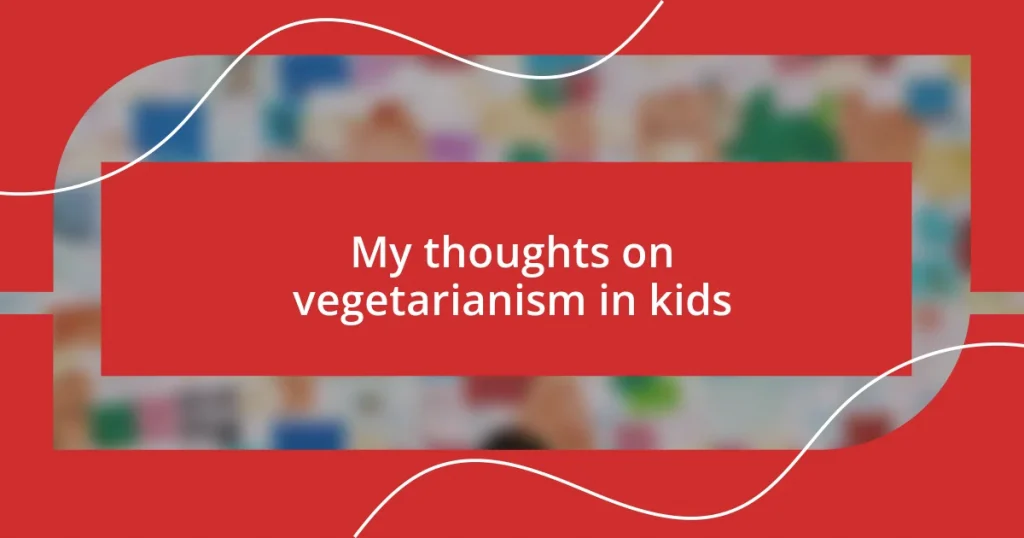Key takeaways:
- A well-stocked vegan pantry should include a variety of grains, legumes, nuts, seeds, spices, and plant-based alternatives to enhance meal flavor and nutrition.
- Efficient organization of the pantry, using clear containers and labels, simplifies meal preparation and helps maintain visibility of ingredients.
- Meal planning, including themes and batch cooking, streamlines the cooking process and promotes a more enjoyable and stress-free experience in the kitchen.

Understanding the vegan pantry basics
When I first delved into vegan cooking, I discovered that understanding the basics of a vegan pantry goes beyond just stocking ingredients. It’s about creating a foundation that supports diverse meals and flavors. I remember rummaging through my kitchen, trying to identify ingredients that would transform my meals from bland to vibrant.
Essential items in a vegan pantry typically include a variety of grains, legumes, nuts, seeds, and spices. I once overlooked how a simple spice could elevate a dish; adding a pinch of smoked paprika to my chickpeas completely changed my perception of vegan food. Have you ever had that lightbulb moment when a seemingly mundane ingredient suddenly transforms your cooking?
Moreover, don’t forget about plant-based alternatives to commonly used pantry staples, like nutritional yeast for a cheesy flavor or coconut milk for creaminess. The first time I added nutritional yeast to my pasta, I was blown away by the cheesy goodness sans dairy. This is the beauty of a well-stocked vegan pantry: it opens up endless possibilities to create hearty, satisfying meals that nourish both body and soul.

Choosing essential vegan ingredients
Choosing essential vegan ingredients can be a delightful yet thoughtful process. With each item added, I’ve seen my meals flourish with color and flavor. I still recall my initial hesitation when I stumbled upon jackfruit in the grocery aisle. I was skeptical about its ability to mimic pulled pork, but once I shredded it and tossed it with my favorite barbecue sauce, I felt like I had struck gold.
Here are some key essential ingredients to consider for your vegan pantry:
- Grains: Quinoa, brown rice, and oats for hearty bases.
- Legumes: Canned beans, lentils, and chickpeas for protein-packed options.
- Nuts and Seeds: Almonds, chia seeds, and hemp seeds for added texture and nutrition.
- Spices and Herbs: Cumin, paprika, basil, and turmeric to elevate any dish.
- Plant-based Dairy Alternatives: Almond milk, coconut yogurt, and cashew cheese for versatile options.
- Condiments: Tahini, nutritional yeast, and soy sauce to enhance flavors and richness.
In my experience, embracing these ingredients has created a sense of adventure in my cooking. It’s incredible how something as simple as miso paste can infuse a dish with umami, transforming an ordinary soup into something memorable. Each ingredient tells a story, and I find joy in discovering how they work together to create comforting meals.

Organizing your pantry efficiently
Organizing your pantry efficiently can make all the difference in how you approach vegan cooking. I remember my first attempt at organization involved shoving everything on a shelf without much thought. It led to frustrating searches for ingredients, often resulting in a half-hearted meal. Once I started sorting my pantry by categories—grains, legumes, spices, and condiments—it transformed my cooking experience. Suddenly, I could whip up a meal on a busy night with ease.
An effective way to maintain this system is utilizing clear containers and labels. I found that labeling jars eliminated the guesswork of rummaging through bags, turning mealtime into a more enjoyable experience. Plus, it feels rewarding to open my pantry and see everything neatly organized. I’ll never forget the first time I made a quick stir-fry and easily found all my spices; it felt like I was cooking like a pro!
When considering storage options, think about the size of your pantry space. Some people may have deep shelves while others are limited to small cabinets. In my own kitchen, I opted for stackable containers to maximize space. It’s interesting how small changes can lead to significant improvements in efficiency. When I kept everything visible and accessible, I discovered ingredients I had completely forgotten about. That old bag of lentils? It’s now a staple in my go-to recipes.
| Storage Method | Benefits |
|---|---|
| Clear Containers | Easy to identify ingredients, space-saving |
| Glass Jars | Eco-friendly, visually appealing |
| Stackable Bins | Maximize space, organized grouping |
| Labels | Quick identification, less mess |

Stocking pantry staples for meals
When stocking pantry staples, I’ve learned that simplicity is key. I often start with versatile grains like quinoa and brown rice; they serve as the perfect foundation for countless meals. It’s funny how something so ordinary can transform into a satisfying bowl with the addition of just a few spices and veggies, don’t you think?
Legumes have become my go-to for boosting nutrition and heartiness in my meals. I distinctly remember the first time I tossed chickpeas into a curry; the protein-packed morsels not only brought substance but elevated the flavor profile. I can’t help but smile when I think of that moment when I realized how filling and delicious a simple chili could be with just a can of beans mixed in. It’s moments like these that remind me of the joy in cooking with plant-based ingredients.
And let’s not forget about spices and condiments—they’re the magic wands of a well-stocked vegan pantry! I still vividly recall experimenting with turmeric and cumin in a chickpea salad; the aroma filled my kitchen and made me feel like a culinary wizard. Have you ever experienced that thrill when your kitchen transforms into a fragrant wonderland? For me, keeping a variety of spices on hand not only adds excitement to my meals but also invites creativity, pushing me to try new combinations and flavors.

Exploring alternative proteins for variety
Exploring alternative proteins has truly expanded my cooking repertoire. When I first started my vegan journey, I often stuck with tofu and tempeh, but then I stumbled upon jackfruit. I remember the first time I used it in a barbecue recipe; the texture mimicked pulled pork perfectly! It added such a unique twist to my meals, making me realize that there’s a whole world of plant-based proteins waiting to be discovered.
Another favorite of mine has become seitan, which is great for those days when I want something super meaty without the actual meat. I was amazed at how versatile it is; I’ve turned it into stir-fries, sandwiches, and even tacos! What surprised me most was the way my non-vegan friends were impressed with seitan tacos at a dinner party. It felt rewarding to share something delicious that showcased the potential of alternative proteins.
Don’t overlook lesser-known options, like pea protein and nutritional yeast, which have proven to be game-changers in my kitchen. I recall experimenting with nutritional yeast in a creamy vegan macaroni dish; it added a cheesy flavor that truly blew me away! Have you tried it? This ingredient not only enhances flavors but also fortifies meals with essential nutrients. Each time I explore an alternative protein, I’m reminded of how beneficial it is for variety and creative cooking in my vegan pantry.

Creating easy meal plans
Meal planning is a game changer, especially in a vegan kitchen. I remember the first time I set aside an hour to map out my week—it was surprisingly liberating. By choosing a few core ingredients, I crafted simple yet delicious meal combinations that not only saved me time but also kept me excited to cook each day. Have you ever thought about how much less stressful grocery shopping can be with a plan in place?
When I create my meal plans, I like to focus on themes for each day. For example, having a “Meatless Monday” where I whip up lentil tacos keeps things fresh and fun. I find that this approach helps me stay organized and motivated. Plus, it’s so rewarding to watch my pantry staples transform into wholesome meals that I can look forward to all week.
I also advocate for batch cooking—making larger portions to enjoy throughout the week. After a busy day, nothing beats pulling out a jar of homemade chili from the fridge, knowing that I’ve already done the hard part. Those cozy nights spent enjoying my well-prepared meals remind me that cooking can be both a pleasurable activity and a means to nourish my body. Have you experienced that unique satisfaction that comes from knowing you’ve got delicious meals ready to go?















